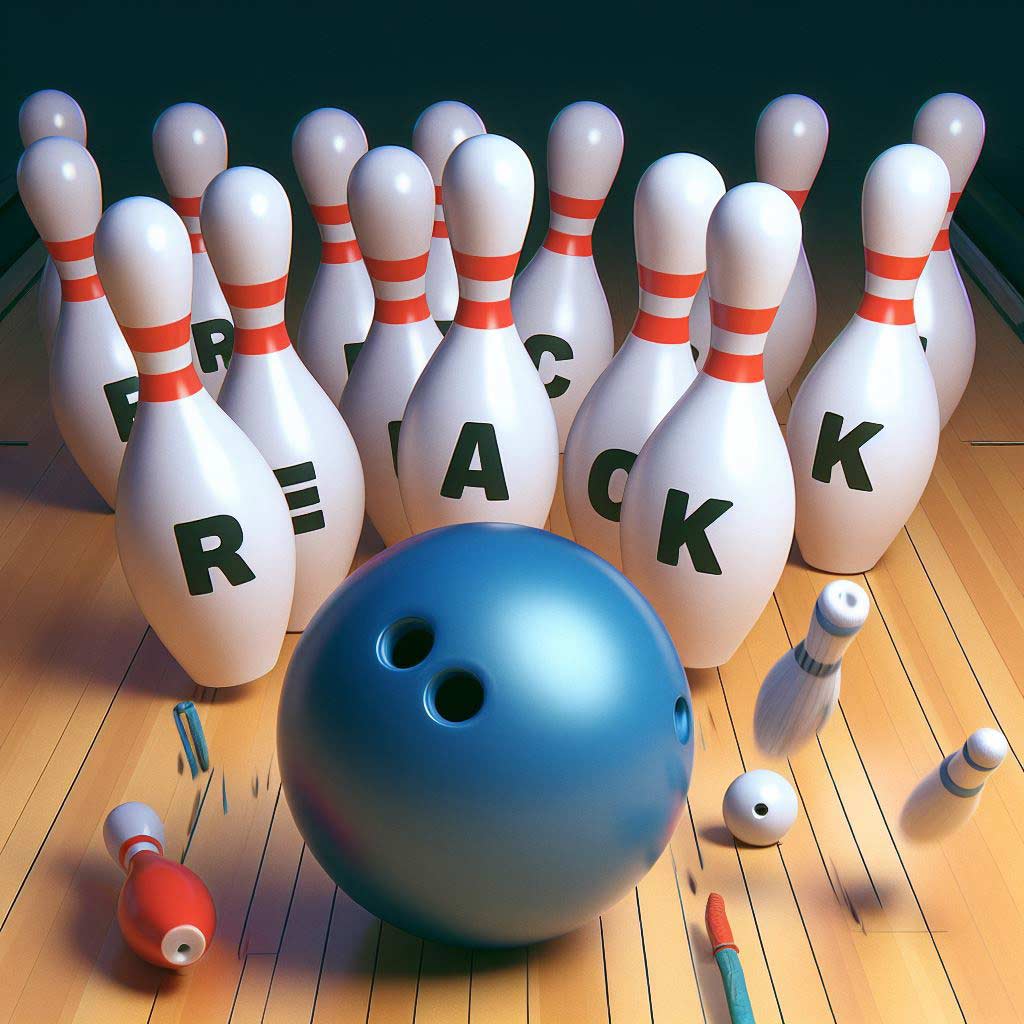If you’ve ever been out for a night of bowling with friends or family, you’ve probably seen bowlers requesting a rerack at some point during their game. But what exactly does it mean when a bowler asks for a rerack?
A rerack refers to resetting the pins in a new configuration before throwing the ball down the lane. Reracking is an accepted part of the sport that allows bowlers to request freshly arranged pins if something is amiss with the current setup.
Understanding the rules around reracks and when you can request one is an important aspect of bowling etiquette and fair play. Read on for a comprehensive guide to everything you need to know about the purpose of reracking when you can request a rerack, the proper protocol to follow, and why reracking helps lead to an enjoyable bowling experience.
What is a Rerack?
In bowling, a rerack occurs when the pinsetter machine picks up downed pins and resets the full rack of 10 pins before the next ball is rolled. Reracking most often happens between frames after a bowler knocks down all 10 pins. But a bowler can also request a rerack mid-frame if the pins are not properly set or interference occurs during their turn.
The primary reasons bowlers request a rerack include:
- The pins are off-spot or leaning significantly, making shooting difficult
- Deadwood from a previous roll is interfering with the setup
- The bowler just threw a strike and wants a clean setup of pins
- The automatic pin setting machine improperly placed the pins
- The bowler simply wants fresh pins at the start of a new frame
While you can’t ask for a rerack simply because you don’t like the pin configuration, bowlers are within their rights to request a fresh setup if the current placement would make picking up spares more difficult. Reracking aims to ensure fair conditions for all players.
When Can You Request a Rerack?
Knowing when it is appropriate to ask for a rerack is key to maintaining proper bowling etiquette. Here are the main situations when requesting a pin rerack is standard practice in bowling:
After a Strike or Spare
One of the most common times bowlers will request a rerack is after picking up a strike or spare. Since you knocked down all the pins, getting a complete reset allows you to start the next roll with ideal pin placement. This is an accepted norm in bowling.
However, some alleys may limit reracks in cases where multiple people in the same lane are bowling consecutive strikes. This prevents excessive delays from too many reracks.
Pins Are Off-Spot or Leaning
Sometimes the automated pinsetting machines can misplace pins, leading to setups where pins are clearly off their spot or leaning precariously. In these cases, you are justified in requesting a rerack so that the pins are properly placed in regulation positions.
Having accurate pin placements is key to being able to pick up tough splits and convert spares. Don’t feel guilty asking for a rerack if the pins are blatantly off.
Pin setting Machine Error
Occasionally there might be a mechanical error that leads to the pinsetting machine improperly placing pins. Maybe it fails to stand all the pins upright or sets up too many/too few pins. When it is obvious the machine made an error, requesting a rerack to correct it is perfectly reasonable.
Deadwood Interference
Deadwood is the bowling term for pins or portions of pins left behind on the lane after a previous roll. If dead wood ends up interfering with the current setup, ask for a rerack to clear it away. Even small fragments can deflect your ball or block you from hitting pins properly.
Start of New Frame
Many bowlers will simply request a fresh set of pins at the start of each new frame as part of their pre-roll routine. This ensures you begin each frame with ideal pin placement and is an accepted norm in bowling, even if not completely necessary.
Rules and Etiquette for Reracks
While you are entitled to request reracks in the above situations, there are certain bowling etiquette rules to keep in mind:
- Know the specific rerack policies at the bowling alley you are at. Some may limit the number of reracks or charge fees.
- Don’t abuse the privilege and only request reracks when truly needed for fair play. Constant reracks can frustrate other players and alley staff.
- Wait for other bowlers on your lane to finish their turns before walking onto the lane for a rerack.
- If there is a dispute about the need for a rerack, politely ask for a second opinion from alley management.
- Allow alley employees to rerack the pins and reset the machine. Do not try to set your pins.
- Limit yourself to 1 or 2 rerack requests per game at most. More than that and it’s best to just play on.
- Be polite when requesting reracks – a simple “Excuse me, could I please get a rerack when you have a chance?” goes a long way.
- If your ball exits the lane during a frame, you forfeit your right to a rerack for that frame.
Following these bowling etiquette guidelines on reracking will help maintain a collegial atmosphere and allow everyone to enjoy the game.
Why Reracks Are Important in Bowling
While it may seem trivial, having proper standards for when and how to rerack in bowling benefits players and bowling centers in some key ways:
Ensures Fair Playing Conditions
The main reason bowlers are allowed reracks is to uphold fair playing conditions. No bowler should have to try picking up a 7-10 split because the pins were badly mis-set. Reracks help even the playing field.
Allows Proper Execution of Shots
From power hooks to well-placed curve shots, bowling requires finesse and skill. But without quality pin placement, even professional bowlers would struggle. Reracking grants all players the setup they need to have a chance at executing techniques correctly.
Avoids Frustration Over Bad Setups
It’s incredibly frustrating when you leave a single pin standing simply because it was off-spot. Allowing reracks prevents bad pin placements from ruining frames and games for bowlers.
Adheres to Standards and Professionalism
Well-run bowling alleys follow protocol and rerack when appropriate. Granting justified reracks elevates bowling to professional sporting standards rather than just a hobby.
Keeps the Sport Moving
While reracks do cause momentary delays, allowing them in fair situations keeps the bowling pace moving smoothly. Bowlers can play on without being blocked by dead wood or improper pin placements.
Ultimately, reracking is part of what makes bowling a true sport requiring precision, concentration, and skill. Following proper etiquette for reracks is key to fair play and enjoyment of the game.
Key Takeaways: Understanding Reracks in Bowling
- A rerack refers to resetting the pins between frames or if pin placement is disrupted during a frame.
- Bowlers can request a rerack at the start of a new frame, after a strike/spare, if pins are off-spot, or if dead wood interferes.
- Don’t abuse rerack privileges and limit requests to 1-2 times per game when truly needed.
- Allow staff to rerack the pins and wait for your turn before stepping up if others are still bowling.
- Be polite when asking for a rerack and follow the bowling alley’s specific rules.
- Reracking ensures fair play, allows proper execution of shots, and adheres to bowling’s professional standards.
Knowing when you can justify a rerack request based on bowling etiquette and rules of the game will ensure you always have the fairest conditions for bowling your best. Proper pin placement standards are an integral part of the sport at all levels.
So next time you step up for league night or a weekend bowling party, keep this rerack guide in mind. Focus on your skill and strategy, and let the reracks handle the rest!
Frequently Asked Questions
What is a bad rack in bowling?
A bad rack refers to an improperly set up configuration of pins that makes it more challenging for the bowler to knock them down. Examples include off-spot pins, leaning pins, dead wood interference, or the machine setting pins in the wrong layout.
What is 5 strikes in bowling called?
In bowling, throwing 5 consecutive strikes is called a five-bagger. This is an impressive feat that requires consistency and skill from the bowler.
What is 4 strikes in bowling called?
Throwing 4 strikes in a row is known as a four-bagger in the bowling world. It’s one strike away from a five-bagger.
What is it called when you miss in bowling?
In bowling lingo, when you fail to knock down all the pins on your first roll it’s called an open frame. The number of pins left standing indicates how challenging the spare shot will be.
What are 9 strikes in a row called?
When a bowler rolls 9 strikes in succession without throwing a non-strike, it’s referred to as a nine-bagger. This is an incredible accomplishment in bowling.
What is 3 spares in a row called in bowling?
Throwing 3 consecutive spares in bowling is known as a triple spare. It demonstrates excellent consistency in picking up the spares.
What is a dinosaur in bowling?
In bowling, a dinosaur refers to alternating strikes and spares in three consecutive frames (X, /, X). The shape of the marks looks like a dinosaur’s spine and tail.
What is 7 strikes in a row called?
Knocking down 7 strikes consecutively is called a seven-bagger in bowling vernacular. It’s one strike short of the impressive eight-bagger.
What is 10 strikes called?
When a bowler achieves 10 strikes in a row within one game it’s referred to as a perfect game or achieving bowling’s holy grail. It’s the highest score possible in a traditional bowling game.





